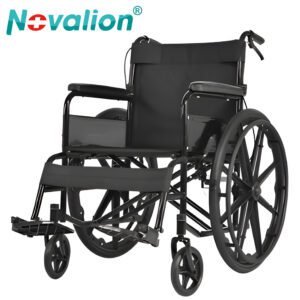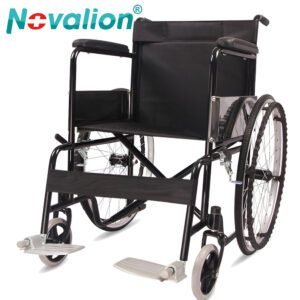Detachable Arm Wheelchair: A Guide to Flexible, Accessible Mobility
For many wheelchair users, transferring in and out of the chair or navigating tight spaces can be challenging—especially with fixed armrests. A detachable arm wheelchair solves these issues by allowing armrests to be removed or folded, adding a layer of flexibility that standard wheelchairs lack. This guide answers all key questions about detachable arm wheelchairs, from their design to how to choose, use, and maintain one.
What is a detachable arm wheelchair?
A detachable arm wheelchair is a mobility device with armrests that can be easily removed or folded out of the way, rather than being fixed to the frame. The detachable mechanism varies: some armrests use quick-release levers (allowing removal in seconds without tools), while others hinge upward or fold down. This design prioritizes accessibility, making transfers (e.g., from bed to chair) simpler by eliminating the barrier of fixed arms. The rest of the wheelchair—frame, wheels, seating—functions like a standard manual wheelchair, but the detachable arms add versatility for daily tasks, tight spaces, or user-specific needs.
How does it differ from a fixed-arm wheelchair?
The key difference lies in the armrest functionality, which impacts usability:
- Transfer ease: Fixed-arm wheelchairs create a physical barrier between the user and surfaces like beds or chairs, forcing users to lift their bodies higher during transfers—a struggle for those with limited strength. Detachable arms remove this barrier, letting users slide directly into the chair with less effort.
- Space navigation: In tight areas (e.g., narrow doorways, bathroom stalls), fixed arms can get caught on walls or fixtures. Detachable arms can be removed or folded to slim the wheelchair’s width, making it easier to maneuver in confined spaces.
- Customization: Detachable arms often offer height adjustment, while fixed arms are static. This allows users to tailor the armrests to their comfort—e.g., raising them to support the elbows during long sits or lowering them for easier transfers.
Who can benefit from a detachable arm wheelchair?
- Users with limited upper-body strength: Individuals who struggle to lift themselves over fixed arms during transfers, such as those with arthritis, post-surgery weakness, or spinal cord injuries.
- Caregiver-assisted users: Caregivers find detachable arms helpful when helping loved ones transfer, as they reduce the physical strain of lifting and positioning.
- Those in tight living spaces: People living in small apartments or using narrow hallways/doorways, where a slimmer wheelchair profile (without arms) prevents collisions.
Users with variable needs: Individuals who sometimes need arm support (e.g., during long outings) but require arm-free access for transfers or tasks like reaching a table.
What features should you prioritize when choosing one?
- Detachable mechanism type: Quick-release levers are ideal for frequent transfers—look for levers that are easy to grip (even with weak hands) and lock securely to prevent accidental detachment. Hinged arms (folding upward) are a good alternative if you rarely need full removal but want occasional space.
- Armrest stability: When attached, the armrests must feel firm—no wobbling. Loose arms can cause discomfort or even injury if they shift during use. Test the fit by pressing down on the armrests; they should stay securely in place.
- Adjustability: Opt for armrests with height adjustment (typically 6–10 inches) to match your seating position. Padded armrests add comfort, especially for users who lean on them during long sits.
- Frame compatibility: Ensure the detachable arms are designed for the wheelchair’s frame. Ill-fitting arms (e.g., from a different brand) may not lock properly, compromising safety.
How to use a detachable arm wheelchair safely?
- Secure attachment checks: Before using the wheelchair, confirm the arms are fully locked into place. A loose armrest can slide or detach during movement, leading to falls or loss of balance.
- Transfer protocol: Remove or fold the arms before After sitting, reattach the arms (if needed) for support—never transfer with one arm attached and one removed, as this can tip the chair.
- Weight limits for arms: Avoid leaning heavily on a single armrest, especially if it’s a folding model. Most armrests support 50–75 lbs of weight; exceeding this can damage the detachable mechanism.
- Maneuvering with removed arms: If navigating without arms, grip the frame or seat edges to steady yourself. Take turns slowly, as the chair may feel less stable without armrests for balance.
What maintenance is required?
- Detachable mechanism care: Clean the quick-release levers or hinges weekly with a dry cloth to remove dirt, which can jam the mechanism. Lubricate moving parts (e.g., hinge pins) monthly with silicone spray to keep removal/folding smooth.
- Armrest stability checks: Tighten any loose screws on the armrests monthly. If an arm feels wobbly even when locked, inspect the locking mechanism for wear—replace damaged parts (e.g., broken levers) promptly.
- Padding upkeep: If armrests have padding, wipe them with mild soap and water to prevent sweat buildup. Replace worn or torn padding to maintain comfort and hygiene.
Are detachable arms available on electric wheelchairs?
Yes, many electric wheelchairs offer detachable or folding armrests, though they’re less common than on manual models. Electric versions often use the same quick-release technology but with reinforced mechanisms to support the chair’s heavier frame. They’re ideal for electric wheelchair users who need transfer help or navigate tight spaces—just ensure the detachable arms are compatible with the electric base, as motorized components (e.g., batteries) can affect fit.
A detachable arm wheelchair transforms daily mobility by prioritizing accessibility without sacrificing functionality. Whether you need easier transfers, slimmer navigation, or customizable support, these wheelchairs offer a practical solution that adapts to your needs.
Thank you for reading this, dear. If you have any suggestions about our website or want to know about wheelchair, please contact us. We will respond quickly.



